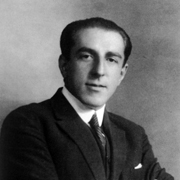Julio Rey Pastor facts for kids
Quick facts for kids
Julio Rey Pastor
|
|
|---|---|
 |
|
| Born | 14 August 1888 Logroño, Spain
|
| Died | 21 February 1962 (aged 73) Buenos Aires, Argentina
|
| Nationality | Spanish |
| Alma mater | Complutense University of Madrid |
| Scientific career | |
| Fields | Mathematics |
| Institutions | Complutense University of Madrid University of Buenos Aires |
| Doctoral advisor | Eduardo Torroja Caballé Felix Klein |
| Doctoral students | Alberto Gonzalez Dominguez Sixto Ríos |
| Seat F of the Real Academia Española | |
| In office 1 April 1954 – 21 February 1962 |
|
| Preceded by | Emilio Fernández Galiano |
| Succeeded by | Manuel Halcón |
Julio Rey Pastor (born August 14, 1888 – died February 21, 1962) was a very important Spanish mathematician. He also studied the history of science. He helped make mathematics modern in both Spain and Argentina.
Contents
A Life in Mathematics
Julio Rey Pastor grew up in Logroño, Spain. He started studying science in Vitoria. Later, he moved to the University of Saragossa. There, he found a great environment for mathematics.
Early Studies and Influences
A professor named Zoel García de Galdeano greatly influenced him. Julio graduated with top honors in 1908. He then earned his doctorate (a very high university degree) in 1909. He got this from the Complutense University of Madrid.
Learning in Germany
Between 1911 and 1914, Julio studied in Germany. He went to the University of Berlin and the University of Göttingen. There, he learned from famous mathematicians like Felix Klein. He also studied with Hermann Schwarz and Ferdinand Georg Frobenius.
Julio sent a report back to Spain about his studies. He really liked Schwarz's lessons. He especially liked Schwarz's teaching style. Julio suggested creating a "seminar in mathematics." This would help students learn how to do research.
Creating a Math Research Center
His idea was accepted! In 1915, a group called the Junta para Ampliación de Estudios (JAE) created the Mathematics Laboratory and Seminar. This was a very important place. It helped mathematics research grow in Spain.
Julio Rey Pastor became a leading figure in math. First in Spain, then in Argentina. The new research center was the first of its kind in Spain. It was not part of a university. He started a research group there. This helped make math research and teaching more modern. He also wrote many advanced math textbooks. These books were very influential in Spanish-speaking countries.
The laboratory helped Spanish mathematicians work together. It was first in the basement of the National Library. Later, it moved to other places. Finally, it became part of a big research group. This group is called the Consejo Superior de Investigaciones Científicas (CSIC). In 1939, it was renamed the Instituto Jorge Juan de Matemáticas.
Spreading Influence to Argentina
Julio Rey Pastor's work included research and writing textbooks. He also wrote articles for everyone to read. These showed how mathematics was changing. He was also very interested in the history of science, especially math in Spain.
From 1921, Rey Pastor lived permanently in Argentina. His influence there was as big as it was in Spain. By the mid-1930s, he led a large group of research students in Buenos Aires. He kept helping math in Spain too. This created two similar math groups. One was in Spain, and one was in Argentina. They worked on similar research projects.
Later Life and Recognition
In 1951, he became the director of the Instituto Jorge Juan de Matemáticas in Spain. He had two main plans for Spain. He wanted to create an Institute of Applied Mathematics. He also wanted to start a Seminar on the History of Science at the university.
In 1954, he joined the Royal Spanish Academy. This is a very important group for language and literature. He had already joined the Academy of Sciences in Madrid in 1920. He also joined the Academy of Sciences in Buenos Aires in 1932.
Rey Pastor loved mathematics. He was a great researcher. He also helped start new studies. He created groups and places that helped math grow in Spain. A lunar crater (a big hole on the Moon) was even named Reypastor by some Moon mappers! However, this name was not officially adopted.
In 1956, he went back to Argentina. He only returned to Spain once. This was to see his student, Sixto Ríos, join the Academy of Sciences in 1961. In his speech, Rey Pastor talked about creating the math laboratory.
Rey Pastor was a member of the Real Academia Española from 1953 to 1962. Spain honored him with a special stamp in 2000.
Works
- 1910: Correspondencia de figuras elemental, con aplicación al estudio de las figuras que engendran (his doctorate thesis)
- 1916: Fondamentos de la geometría proyectiva superior (Foundations of Higher Projective Geometry)
- 1916: Introducción a la matemática superior (Introduction to Higher Mathematics)
- 1942: La Ciencia y la Técnica en el Descubrimiento de América (Science and Technology in the Discovery of America)
- 1957: Apuntes de la teoría de los conjuntos abstractos (Notes on the Theory of Abstract Sets)
See also
 In Spanish: Julio Rey Pastor para niños
In Spanish: Julio Rey Pastor para niños
- António Aniceto Monteiro

